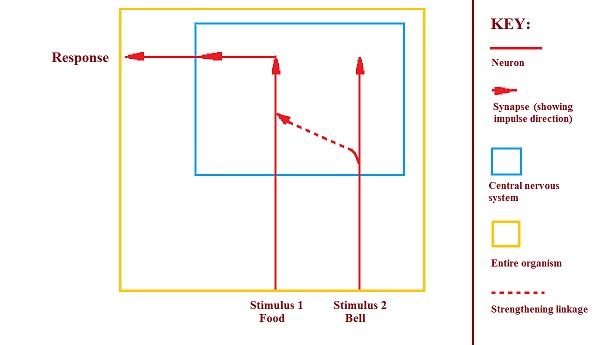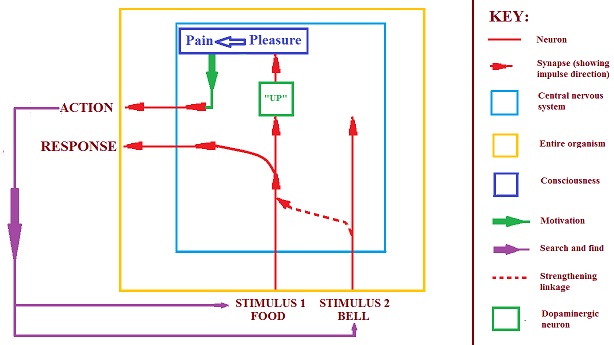The Guess Worker
Learning
Overview:
-
Animals learn by linking neurons in their brains
-
The more often neurons fire, the stronger the linkages between them
-
Pain motivates a search for stimuli which results in neurons firing more often
-
A stimulus which causes pain triggers searches for itself and other stimuli
-
In this way consciousness promotes associations between important stimuli
American black bears are opportunists. The diet of these omnivores vary depending on their habitats and the seasons. They will eat what they can find or catch: fruit, berries, nuts, tubers, insects, fish, rodents, deer, edible garbage from humans - and, of course, honey. If a black bear hears a buzzing-noise in the forest, it might think to itself along these lines: "the only reason for making a buzzing-noise that I know of is because you're a bee. And the only reason for being a bee that I know of is making honey. And the only reason for making honey is so as I can eat it."
The benefits of learning
In fact there was only one bear who thought in exactly these words and that bear was Winnie-the-Pooh. Nevertheless, just like Pooh, real bears probably do learn to associate the buzzing of bees with food – even if they don't use his string of conscious reasoning to do so. Learning is useful, especially if the environment is challenging. It means that an animal can use new stimuli to adapt its behaviour and so take advantage of new opportunities and avoid new dangers.
What is happening in the brain of a bear when it learns that a buzzing-noise means honey? This particular association has never been studied in the laboratory but a similar one has – that of dogs linking the sound of a bell to food in Pavlov's conditioning experiments. So I'll use this example to speculate on what might be going on. For now I'll consider the simplest variation of the experiment – when the bell is rung at the same time that the dogs are given food.
The most straightforward mechanism
In Hope I suggested that a linkage between two neurons is strengthened when the two neurons are fired simultaneously. It could be that the mechanism of conditioning is as straightforward as that: the more the neurons responding to food and the sound of the bell are activated together, the stronger the connection between them will become. How this strengthening results in conditioning is shown below:
 "
"
When the linkage is sufficiently strong, either stimulus will produce the same response. Because the neurons are connected, impulses starting at either the bell or the food sensory receptor will end up being passed on to the same motor neurons.
A hungry search
This mechanism, though, can't adequately explain what is happening in the dogs' brains.*1 Somehow hunger influences conditioning: hungry dogs are easier to condition to the sound of the bell than are well-fed dogs. But how?
The answer is: by motivating. Pain and pleasure make an animal search for favourable stimuli.*2 Two kinds of stimuli appeared on Pavlov's dogs' radar when they were searching: food and the bell. Neurons from each stimulus were activated and, with repetition, a strong linkage were formed between them. This idea is illustrated below:
 "
"
Hunger is the pain which kicks off the search and that makes the animal pick up on the two stimuli occurring simultaneously. Pain, then, makes it more likely that strong linkages are formed – the search caused by pain makes sure that the neurons fire more often.
But that can't be the whole story. Animals don't associate any random stimuli when they feel pain. It wouldn't be useful, let's say, for Pavlov's dogs to link the sound of the bell to the bed mats they sleep on. They have to link the sound specifically to food – because food is what they need to satisfy their hunger.
How then do the dogs link only the relevant stimuli? To understand that, we first have to know about salience.*3
The importance of being salient
Salience is a term used by psychologists to describe the importance an animal attaches to a stimulus. A loud noise, for example, will usually be a salient stimulus because it is noticed by the listener. For most people a chocolate eclair is more salient than cold porridge. That's because chocolate eclairs are more appealing than cold porridge and are therefore more likely to draw our attention.
The salience of a stimulus affects how easily an animal can be conditioned. You are likely to have more success teaching your dog a trick if you reward him with a biscuit than with a pat on the head. Pats on the head are not nearly as salient as biscuits.
Curiously, the salience of a stimulus can vary depending on circumstances. Chocolate eclairs become less salient as you eat more of them and on the other hand even cold porridge can become quite salient if you feel famished enough. The same principle works for Pavlov's dogs: they are easier to condition when they are hungry because in that state their food is more salient than when they are well-fed.
Those who have read my previous posts might be able to guess what I am going to claim salience is: it is the steepness of the rises and falls of dopamine in dopaminergic neurons in the brain. In general chocolate eclairs give us steeper rises than does cold porridge. That makes chocolate eclairs more pleasurable, and therefore more salient.
However if you have already eaten a few chocolate eclairs, the next one won't be as salient because the rise in dopamine will be less steep.*4 And, on the other hand, if you are very hungry, even cold porridge will look tasty because hunger makes the rises in dopamine steeper.
What makes you want to eat either eclairs or porridge is not the rises in dopamine but the subsequent falls. Steeper falls come after steeper rises – so you will experience a sharp rise in dopamine if you see an eclair when you're hungry, but you will also experience a sharp fall once the dopamine has peaked. The sharp fall is painful and is felt as a want for the eclair. We sometimes call this want appetite and it is stronger the hungrier you are.
Hunger by proxy
So hunger is reflected in appetite. And because appetite mirrors hunger, it could be that appetite plays hunger's role in conditioning. Perhaps appetite, instead of hunger, motivates the linking of the stimuli in the last diagram. Since appetite itself is evoked by sensing food, that would mean that food (that is, the appearance, smell or taste of the food) is the trigger which sets off the events leading to the linking. How this might work is shown below:
 "
"
We can summarise what happens like this: after the dogs are shown food, there are rises followed by falls of dopamine in their dopaminergic neurons. The falls motivate the dogs to search for stimuli. In their search they look at the food again and hear the sound of the bell. This simultaneously activates the neurons linked to the two stimuli. As long as the dopamine levels fall, the neurons fire together, and with repeated firing a linkage between them develops and strengthens.
If the dogs are very hungry, the falls in dopamine are steeper than if they were well fed. These sharp falls in hungry dogs set off an intense search. That means hungry dogs activate the relevant neurons more frequently than do well fed dogs - and as a result the linkage between the neurons in their brains is stronger and forms more quickly.
An odd double take
One sentence in the description above might seem a bit odd: I say the food makes the dogs look at the food again. Can this really be true? Can a stimulus make an animal search for the very same stimulus over and over? The answer is: definitely. We all know from experience that we stare at things we find attractive or amazing. If that something takes us by surprise, we might do a "double take": we take a long second look. We gaze at beautiful faces, we glare enviously at the neighbour's new car, we gawp at someone walking naked in the street - and the dog fixes his eyes wistfully at the biscuit in your hand while you are trying to teach him a trick.
Why do we stare so much? What's the point in reintroducing ourselves to a stimulus that we've already noticed? The reason is to activate repeatedly the neurons connected to that stimulus. That increases the chances that these neurons will link up to other - and possibly new - stimuli which occur at the same time. We stare in order to make new connections.
What consciousness does, through the instruments of pain and pleasure, is give emphasis to specific stimuli. Without consciousness, any stimuli which frequently occur together can become associated. The problem is that these stimuli may not be useful for the animal. Consciousness prioritises the stimuli: it makes sure that those stimuli which are the most important are connected the quickest and with the strongest linkages.
A stimulus of no importance?
Of the two stimuli in Pavlov's conditioning, food is the important one. It is the stimulus which gives the dogs significant pleasure and pain. The second stimulus – the sound of the bell – can be seen almost as an irrelevance. It becomes associated with food only because it happens to be there at the same time. But in fact this stimulus (known as a conditioned or neutral stimulus) is probably neither as unimportant nor as neutral as we might think.
If we look at the diagram above again, we can see that it is incomplete. The neuron coming from the neutral stimulus isn't going anywhere. It's a loose end. This can't be right. Neurons are always connected to something: sensory neurons are connected either to motor neurons to cause a response, or to dopaminergic neurons to give pain and pleasure.
In the next post I'm going to look at how neutral stimuli are important and to deduce what the neurons activated by them are connected to. As I do so, I'm going to show how neutral stimuli led to humans becoming conscious of a wide range of different experiences.
*1. It might explain, though, how some apparently unconscious animals learn. Honeybees for example can be trained to fly onto blue coloured cardboard by conditioning them with a sweet reward. On occasions even conscious animals may be able to learn unconsciously in this way.
*2. See Evolution and Dopamine for my reasoning. As I explain in the latter post pleasure makes animals seek favourable stimuli in an indirect way. Pleasurable rises in dopamine are followed by painful falls – and it is these falls which motivate.
*3. Not to be confused with incentive salience, a term coined by Kent Berridge of Michigan University to describe the motivation of animals to salient stimuli. For more on this see Is Kent Berridge wrong? and A conversation with Kent Berridge.
*4. See The dynamics of pleasure.

Comments powered by CComment